SPI中的极性CPOL和相位CPHA
详解SPI中的极性CPOL和相位CPHA
(2) CKPHA (Clock Phase) = CPHA = PHA = Phase = (时钟)相位
(3) SCK=SCLK=SPI的时钟
(4) Edge=边沿,即时钟电平变化的时刻,即上升沿(rising edge)或者下降沿(falling edge)
- 极性=CPOL
- 相位=CPHA
- SCLK=时钟
- 第一个边沿和第二个边沿
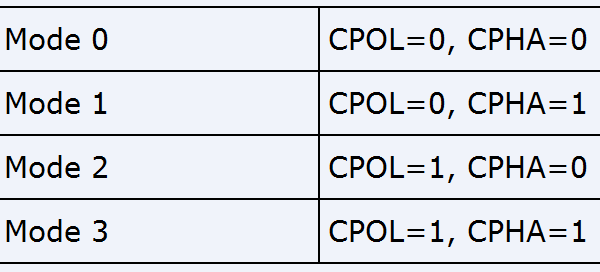
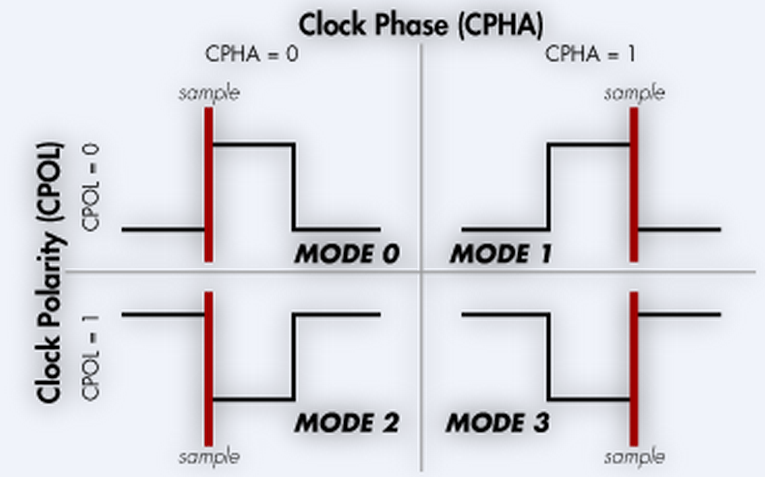
CPOL极性
先说什么是SCLK时钟的空闲时刻,其就是当SCLK在发送8个bit比特数据之前和之后的状态,
CPOL=0,时钟空闲idle时候的电平是低电平,所以当SCLK有效的时候,就是高电平,就是所谓的active-high;
CPOL=1,时钟空闲idle时候的电平是高电平,所以当SCLK有效的时候,就是低电平,就是所谓的active-low;

CPHA相位
首先说明一点,capture strobe = latch = read = sample,都是表示数据采样,数据有效的时刻。
对于CPOL=0,idle时候的是低电平,第一个边沿就是从低变到高,所以是上升沿;
对于CPOL=1,idle时候的是高电平,第一个边沿就是从高变到低,所以是下降沿;
对于CPOL=0,idle时候的是低电平,第二个边沿就是从高变到低,所以是下降沿;
对于CPOL=1,idle时候的是高电平,第一个边沿就是从低变到高,所以是上升沿;
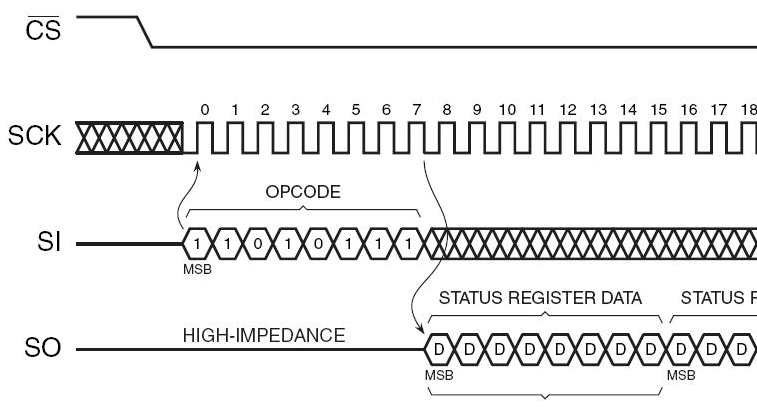
如何判断CPOL和CPHA
(1)如何判断CPOL:SCLK的空闲时候的电压,是0还是1,决定了CPOL是0还是1;
(2)如何判断CPHA:而数据采样时刻对应着的SCLK的电平,是第一个边沿还是第二个边沿,对应着CPHA为0还是1。

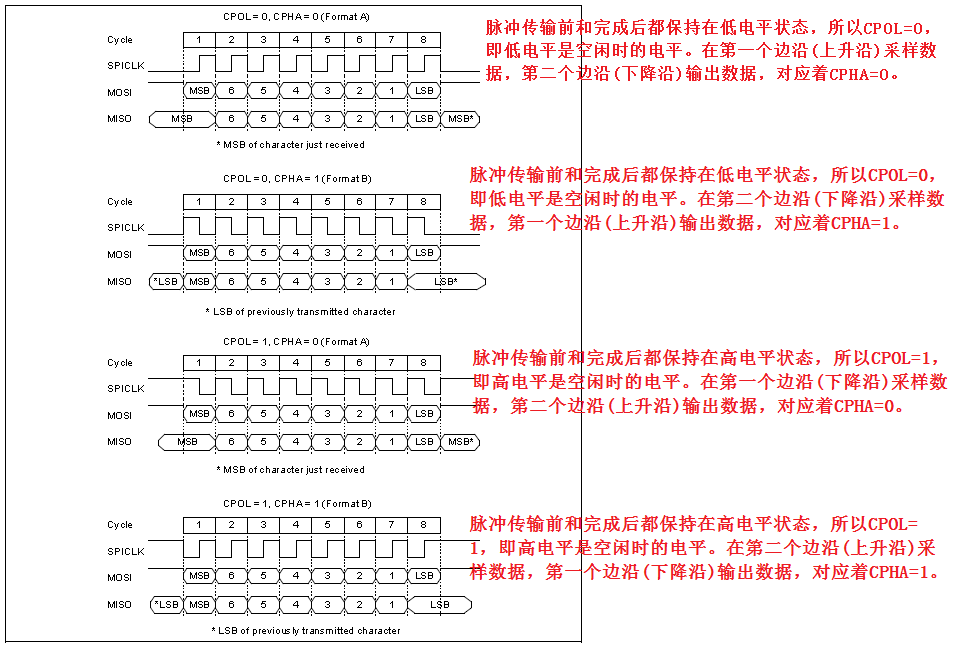
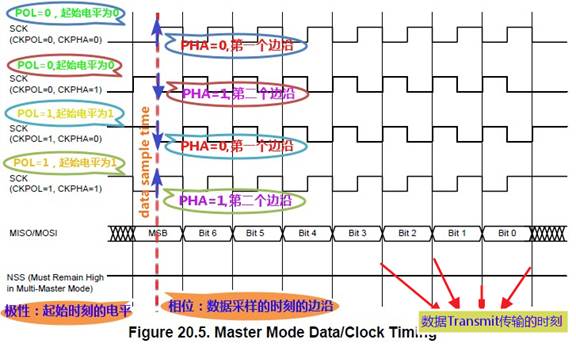
此处,再多解释一下可能会遇到的CKP和CKE,其是Microchip的PIC系列芯片中的说法。
(1)CKP是Clock Polarity Select,就是极性=CPOL:
CKP,虽然名字和CPOL不一样,但是都是指时钟相位的选择,定义也一样:
CKP: Clock Polarity Select bit
1 = Idle state for clock (CK) is a high level
0 = Idle state for clock (CK) is a low level
所以不多解释。
(2)CKE是Clock Edge Select,就是相位=CPHA:
CKE: SPI Clock Edge Select bit
1 = Transmit occurs on transition from active to Idle clock state
0 = Transmit occurs on transition from Idle to active clock state
意思是
1 =(数据)传输发生在时钟从有效状态转到空闲状态的那一时刻
0 =(数据)传输发生在时钟从空闲状态转到有效状态的那一时刻
其中,数据传输的时刻,即图中标出的“数据transmit传输的时刻”,很明显,
该时刻是一个时钟和下一个时钟之间交界的地方,对应的不论是上升沿还是下降沿,
都与我们前面提到的CPHA=数据采样的时刻,的边沿方向所相反。
所以,此处的CKE,正好与CPHA相反。
所以,CKP和CKE所对应的取值的含义为:
When CKP = 0: CKE=1 => Data transmitted on rising edge of SCK, CKE=0 => Data transmitted on falling edge of SCK
When CKP = 1: CKE=1 => Data transmitted on falling edge of SCK, CKE=0 => Data transmitted on rising edge of SCK
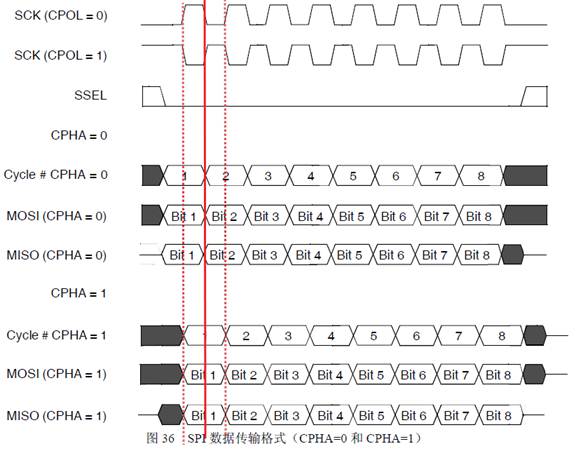
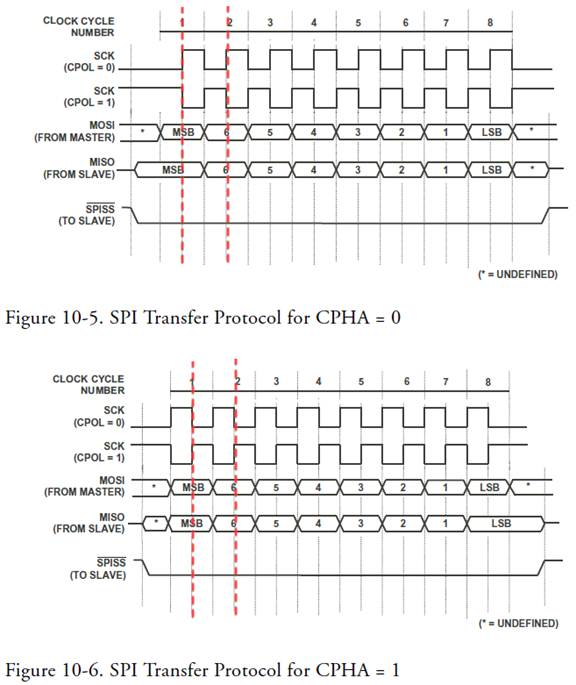
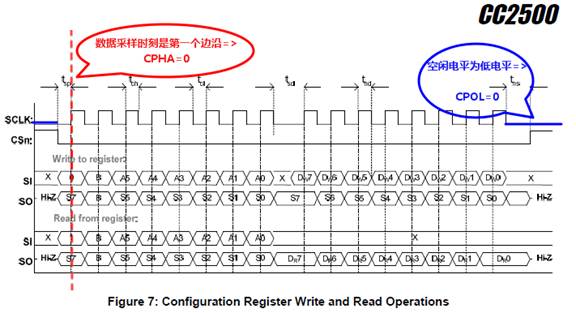
STM32F4 SPI Data clock timing diagram
Clock phase and clock polarity
Four possible timing relationships may be chosen by software, using the CPOL and CPHA bits in the SPI_CR1 register.
The CPOL (clock polarity) bit controls the steady state value of the clock when no data is being transferred.
This bit affects both master and slave modes.
If CPOL is reset, the SCK pin has a low-level idle state.
If CPOL is set, the SCK pin has a high-level idle state.
If the CPHA (clock phase) bit is set, the second edge on the SCK pin is the MSBit capture strobe.
(falling edge if the CPOL bit is reset, rising edge if the CPOL bit is set)
Data are latched on the occurrence of the second clock transition.
If the CPHA bit is reset, the first edge on the SCK pin is the MSBit capture strobe.
(falling edge if CPOL bit is set, rising edge if CPOL bit is reset)
Data are latched on the occurrence of the first clock transition.
The combination of the CPOL (clock polarity) and CPHA (clock phase) bits selects the data capture clock edge.
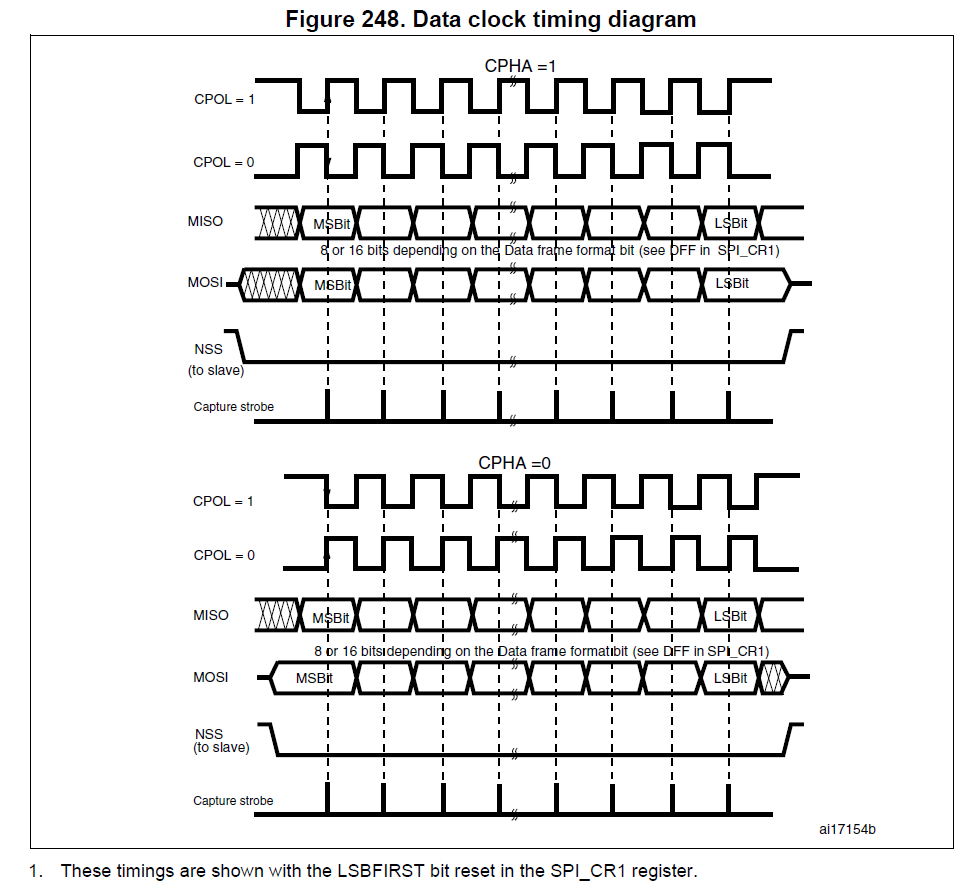
Figure 248, shows an SPI transfer with the four combinations of the CPHA and CPOL bits.
The diagram may be interpreted as a master or slave timing diagram
where the SCK pin, the MISO pin, the MOSI pin are directly connected
between the master and the slave device.
Note:
Prior to changing the CPOL/CPHA bits the SPI must be disabled by resetting the SPE bit.
Master and slave must be programmed with the same timing mode.
The idle state of SCK must correspond to the polarity selected in the SPI_CR1 register
(by pulling up SCK if CPOL=1 or pulling down SCK if CPOL=0).
The Data Frame Format (8- or 16-bit) is selected through the DFF bit in SPI_CR1 register,
and determines the data length during transmission/reception.
SPI Transfer Modes
SPI interface allows to transmit and receive data simultaneously on two lines (MOSI and MISO).
Clock polarity (CPOL) and clock phase (CPHA) are the main parameters
that define a clock format to be used by the SPI bus.
Depending on CPOL parameter, SPI clock may be inverted or non-inverted.
CPHA parameter is used to shift the sampling phase.
If CPHA=0 the data are sampled on the leading (first) clock edge.
If CPHA=1 the data are sampled on the trailing (second) clock edge,
regardless of whether that clock edge is rising or falling.
CPOL=0, CPHA=0
The data must be available before the first clock signal rising.
The clock idle state is zero.
The data on MISO and MOSI lines must be stable while the clock is high and can be changed when the clock is low.
The data is captured on the clock's low-to-high transition and propagated on high-to-low clock transition.
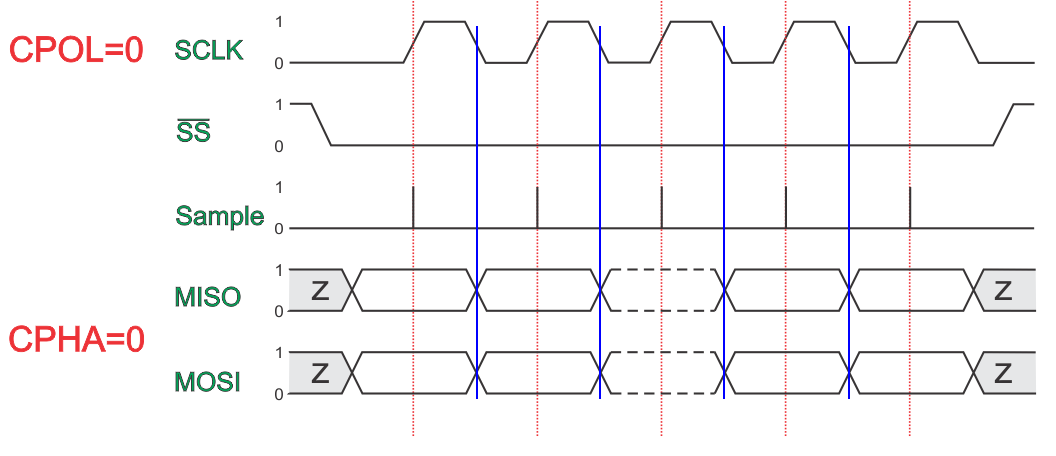
CPOL=0, CPHA=1
The first clock signal rising can be used to prepare the data.
The clock idle state is zero.
The data on MISO and MOSI lines must be stable while the clock is low and can be changed when the clock is high.
The data is captured on the clock's high-to-low transition and propagated on low-to-high clock transition.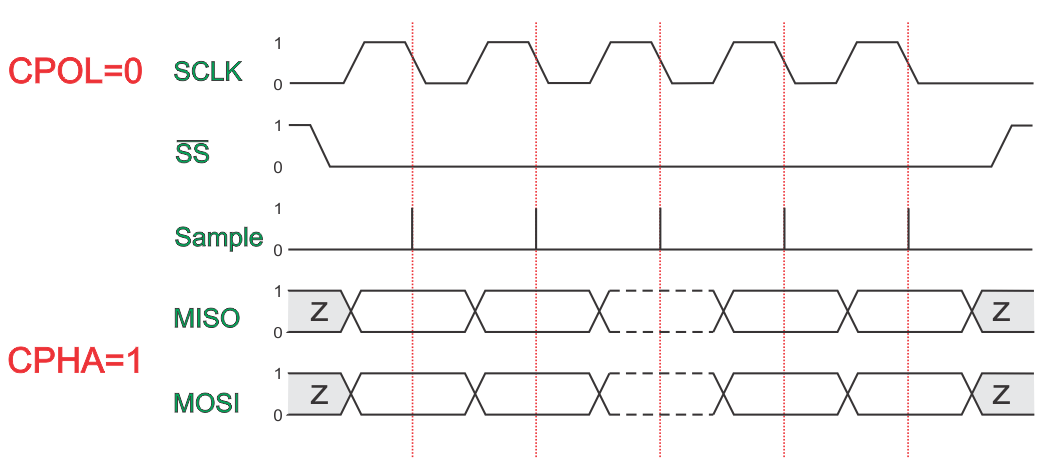
CPOL=1, CPHA=0
The data must be available before the first clock signal falling.
The clock idle state is one.
The data on MISO and MOSI lines must be stable while the clock is low and can be changed when the clock is high.
The data is captured on the clock's high-to-low transition and propagated on low-to-high clock transition.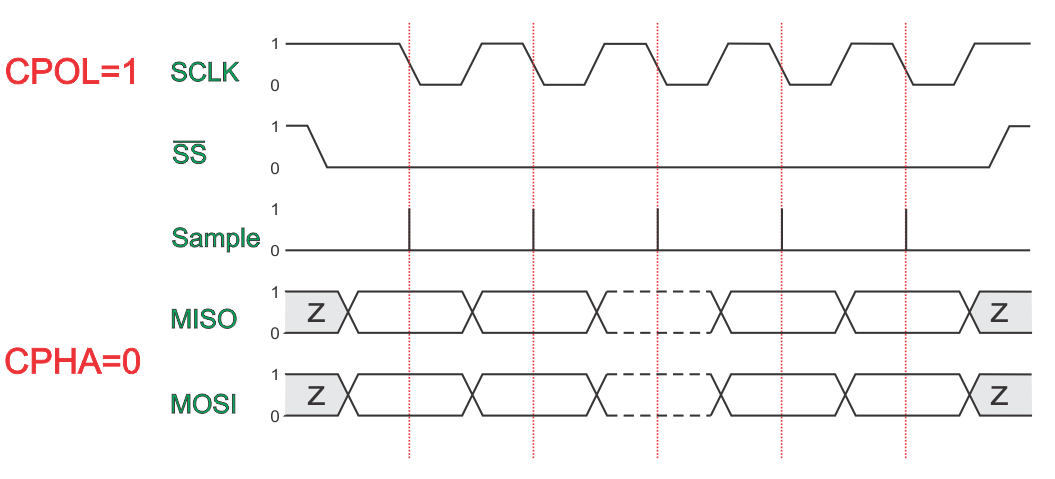
CPOL=1, CPHA=1
The first clock signal falling can be used to prepare the data.
The clock idle state is one.
The data on MISO and MOSI lines must be stable while the clock is high and can be changed when the clock is low.
The data is captured on the clock's low-to-high transition and propagated on high-to-low clock transition.
SPI Modes and Timing.
Introduction
In a lot of cases, when using SPI, we do need to use "SPI_Init_Advanced".
It has a number of parameters. Here the parameters regarding the SPI "mode" are described. The "mode" consists of
- The SPI clock (SCK) polarity (parameter clock_idle)
- The PIC SPI data out transmit edge (parameter edge)
in
procedure SPIx_Init_Advanced(..., data_sample, clock_idle, edge: word);
The "data_sample" parameter does not belong to the actual "SPI mode", it is an extra feature of the MCU, see here.
The SPI "Modes"
SPI knows 4 "standard" modes, reflecting the SCK's polarity (CPOL) and the SCK's phase (CPHA).
The definition is:
| SPI Mode | CPOL | CPHA |
|---|---|---|
| 0 (or 0,0) | 0 | 0 |
| 1 (or 0,1) | 0 | 1 |
| 2 (or 1,0) | 1 | 0 |
| 3 (or 1,1) | 1 | 1 |
The meaning is:
CPOL:
- 0 = Clock Idle low level
- 1 = Clock Idle high level
CPHA:
- 0 = SDO transmit edge (*) active to idle
- 1 = SDO transmit edge idle to active
(*): the transmit edge is the clock edge at which the SDO level changes
In a timing diagram this looks like(only one clock pulse shown here):
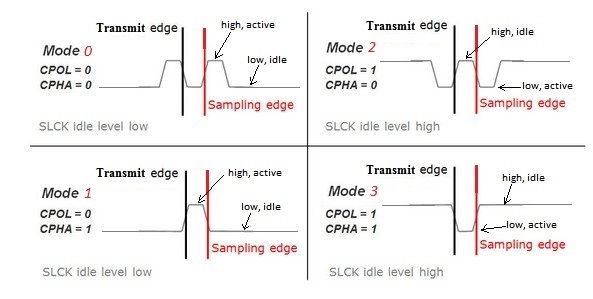
The Transmit edge is the clock edge at which the SPI output data changes,
the Sampling edge is the clock edge at which the sampling of the SPI input data takes place.
The sampling edge is normally the opposite one of the transmit edge, but see also here.
SPI and PIC/ dsPIC
The PIC MCU supports a 4 SPI modes, but the MCU registers involved are named differently and behave differently.
The 2 MCU registers are CKP (Clock Polarity) and CKE (Clock edge).
The relation between those 2 registers and the SPI modes is:
| SPI Mode | CKP | CKE |
|---|---|---|
| 0 (or 0,0) | 0 | 1 |
| 1 (or 0,1) | 0 | 0 |
| 2 (or 1,0) | 1 | 1 |
| 3 (or 1,1) | 1 | 0 |
As you can see, CKP behaves the same as CPOL, CKE is the inverse of CPHA.
This means that a simple "SPI_Set_mode" looks like this:
procedure Set_SPI_mode(CPOL_, CPHA_: byte);
// The 2 paremeters are:
// CPOL: SPI clock polarity: 0 = Clock Idle LOW; 1 = Clock Idle HIGH
// CPHA: SPI clock Phase: 0 = Transmit edge active to idle; 1 = Transmit edge Idle to active
begin
CKP_bit := CPOL_;
CKE_bit := (CPHA_ xor 1) and 1; // invert bit zero
end;
Above routine can e.g. used after a usage of an mE SPIx_Init... routine to (re)set the SPI mode.
The mE SPI library usage
In the mE SPI library the "SPI mode" is set by 2 parameters of the "SPIx_Init_Advanced" function.
The the parameters for PIC are : "clock_idle" and "transmit_edge"
The the parameters for dsPIC are: "clock_idle" and "edge"
Important: in both cases the last parameter ("transmit edge" or "edge" parameter) is
NOT the transmit edge, but the other one, called the "Sampling edge",
see here. As you can see the name of the PIC parameter is wrong (it says "transmit_edge").
Furthermore the constant values used to give the parameters their values are:
For PIC:
CPK: _SPI_CLK_IDLE_LOW and _SPI_CLK_IDLE_HIGH
CPE: _SPI_LOW_2_HIGH, _SPI_HIGH_2_LOW (**)
For dsPIC:
CPK: _SPI_CLK_IDLE_LOW and _SPI_CLK_IDLE_HIGH
CPE: _SPI_ACTIVE_2_IDLE, _SPI_IDLE_2_ACTIVE (**)
(**) Again: the "edge" is the "Sampling Edge", not the "Transmit Edge", see here.
Deriving the parameters from the device's "SPI mode"
The easiest way is using the "SPI mode" if known, the hardest is deriving the parameters from the device's timing diagram.
The table below gives the relationship between an SPI device's "SPI mode" and the parameter values to use with "SPIx_Init_Advanced":
| SPI MODE | clock idle parameter | Edge parameter = the "Sampling" edge |
|---|---|---|
| 0,0 | _SPI_CLK_IDLE_LOW | _SPI_LOW_2_HIGH (pic) : _SPI_IDLE_2_ACTIVE (dsPIC) |
| 0,1 | _SPI_CLK_IDLE_LOW | _SPI_HIGH_2_LOW (pic) : _SPI_ACTIVE_TO_IDLE (dsPIC) |
| 1,0 | _SPI_CLK_IDLE_HIGH | _SPI_HIGH_2_LOW (pic) : _SPI_IDLE_TO_ACTIVE (dsPIC) |
| 1,1 | _SPI_CLK_IDLE_HIGH | _SPI_LOW_2_HIGH (pic) : _SPI_ACTIVE_TO_IDLE (dsPIC) |
Important:
In mikroPascal the parameter "edge" represents the clock edge where in input data is sampled,
not the "transmit edge" (the clock edge at which the SDO data is changed).
The parameter "data sample" is not included in the "SPI mode",
but usually "_SPI_DATA_SAMPLE_MIDDLE" will do fine, see however also here.
Defining parameters from the device's timing diagram
This manner has to be applied if the "SPI mode" of the device at hand is not (explicitely) defined.
To find out the necessary values of the parameters we have to look to the device's SPI timing diagram we want to handle:
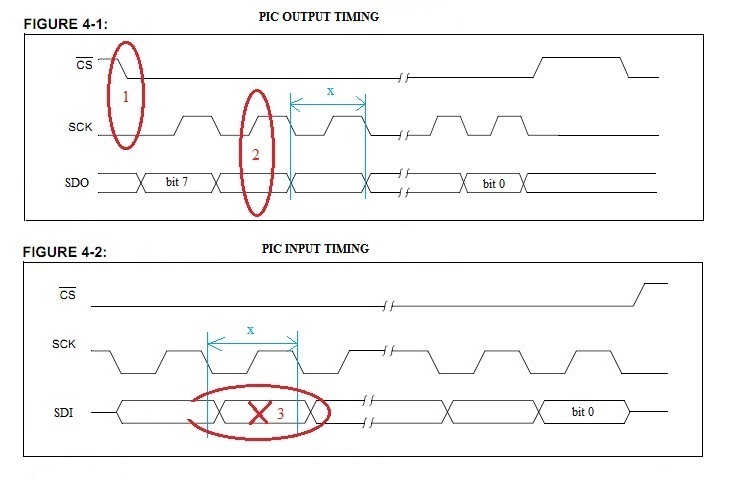
Keep in mind that in the "device" diagram the "device" timing is shown.
For the PIC timing input and output should be interchanged (which was already done in the above diagram,
it shows the timing from the PIC's perspective).
1. The "clock_idle" parameter
See 1 in the diagram. The level wanted is the SCK level at the moment notCS changes. In the diagram this level is zero, so: theclock idle is low.
This means also that (again in our case) the clock active level is high.
2. The "edge" parameter
See 2 in the diagram. The edge wanted is the one in the middle between 2 PIC output (PIC SO) datachanges (two "transmit" edges, represented by "x" in the timing diagram).
In our case we see that it is the edge from low to high, or from idle to active.
The "data_sample" parameter
The data_sample parameter is not defined in the SPI mode, it is an extra feature of the MCU.
Normally the "Sampling edge" (see here) is the opposite one of the "transmit edge".
This is achieved by setting the "data_sample" parameter to the value "_SPI_DATA_SAMPLE_MIDDLE".
The sampling moment can however be shifted to the same moment as the transmit edge
by setting the "data_sample" parameter to the value "_SPI_DATA_SAMPLE_END" value, see here).
How to define which one to use:
See 3 in the above diagram.
First define the "data output time", represented by an x in the timing diagram.
It is the time from one PIC output data (PIC SO) change to the next.
Now compare the device data out (SO = PIC SI) with the "data output time".
The data_sample value we have is the best moment in the "data output time"
the PIC should take a sample of its input data (the device output data).
In our case, the middle of the "data output time" seems to be the most appropriate (at the end would be not bad either).
Info
a. Timing diagram (derived and modified from Mchp datasheet)
This is the (master) timing diagram with the terms explained:
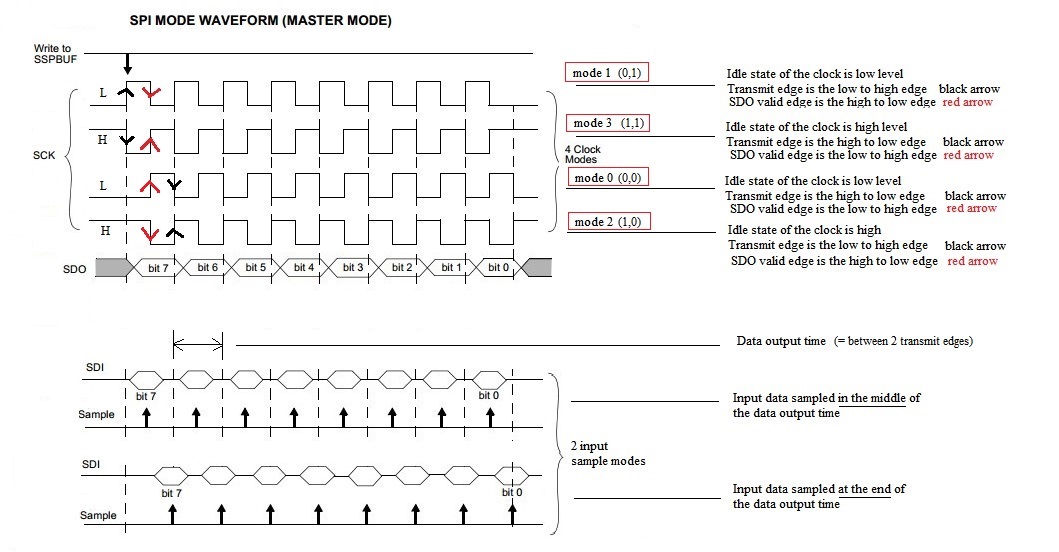
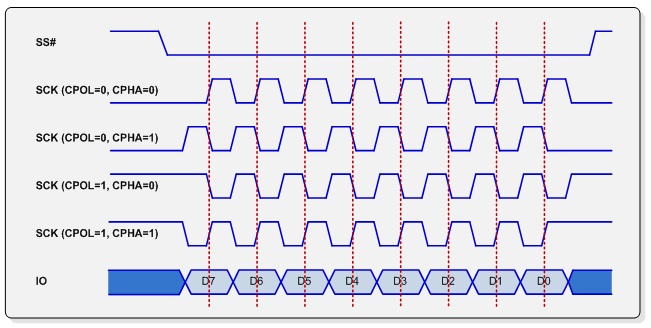
SPI中的极性CPOL和相位CPHA的更多相关文章
- 详解SPI中的极性CPOL和相位CPHA
SPI由于接口相对简单(只需要4根线),用途算是比较广泛,主要应用在 EEPROM,FLASH,实时时钟,AD转换器,还有数字信号处理器和数字信号解码器之间.即一个SPI的Master通过SPI与一个 ...
- 嵌入式开发之davinci--- spi 中的时钟极性CPOL和相位CPHA
PI的极性Polarity和相位Phase,最常见的写法是CPOL和CPHA,不过也有一些其他写法,简单总结如下:(1) CKPOL (Clock Polarity) = CPOL = POL = P ...
- Dubbo学习笔记6:Dubbo增强SPI与SPI中扩展点自动包装的实现原理
在Dubbo整体架构分析中介绍了Dubbo中除了Service和Config层为API外,其他各层均为SPI,为SPI意味着下面各层都是组件化可以被替换的,也就是扩展性比较强,这也是Dubbo比较好的 ...
- (转)SPI时钟极性、时钟相位
SPI协议是一个 4 线.全双工的串口协议.根据串口时钟SCLK的相位SCPH和极性SCPOL的不同,有 4 种组合. CPOL CPHA MODE0 0 0 MODE1 0 1 MODE2 1 0 ...
- ServiceLoader在SPI中的重要作用分析
对于线程上下文类加载器在之前已经对它进行了详细的理论化的学习,其中对于这个类加载器应用最多的也就是在SPI场合下用来打破双亲委托机制,如之前所描述的: 这次举一个具体的例子来进一步的加深对线程上下文类 ...
- SPI相位跟极性介绍
[详解]SPI中的极性CPOL和相位CPHA是什么以及如何设置 2012-03-0214:34:10| 分类:单片机 | 标签: |字号大中小 订阅 版本:2011-08-15 作者:crif ...
- SPI总线介绍
1. 简介 SPI, Serial Peripheral Interface, 串行外设接口, 是一种高速的.全双工.同步的通信总线SPI在芯片的管脚上只占用四根线 SPI接口主要用于MCU与各种外围 ...
- STC8A8K64S4A12通过SPI接口操作基于ST7920的LCD12864液晶模块
文章地址:https://www.cnblogs.com/jqdy/p/12665430.html 1. 硬件连接 1.1 64引脚的STC8A8K64S4A12 使用的是最小核心板,所以引脚皆引出可 ...
- SPI详解2
串行外设接口 (SPI) 总线是一种运行于全双工模式下的同步串行数据链路.用于在单个主节点和一个或多个从节点之间交换数据. SPI 总线实施简单,仅使用四条数据信号线和控制信号线(请参见图 1). 图 ...
随机推荐
- Requests中出现大量ASYNC_NETWORK_IO等待
七夕活动,网页显示异常:504 Gateway Time-out The server didn't respond in time.开发询问数据库是否正常,当时正连接在实例上查询数据,感觉响应确实慢 ...
- Javascript - Vue - vue对象
vue提供了一整套前端解决方案,可以提升企业开发效率 vue的处理过程 app.js 项目入口,所有请求最先进入此模块进行处理 route.js 由app.js调用,处理路由的分发 controlle ...
- 有用的linux命令集锦
http://blog.csdn.net/hackerain/article/details/7946193 1. 查看内存使用情况 free -m 2. 查看系统版本信息 sudo lsb_rele ...
- mysql学习------MySQL慢查询日志
一.什么是慢查询日志 1.当查询超过一定时间没有返回结果的时候,才会记录进慢查询日志 2.慢查询日志可以帮助dba找出执行效率缓慢的sql语句,为数据库的优化工作提供帮助 3.慢查询日志默认是不开启的 ...
- mysqldump只导出表结构或只导出数据的实现方法【转】
mysql mysqldump 只导出表结构 不导出数据 mysqldump --opt -d 数据库名 -u root -p > xxx.sql 备份数据库 #mysqldump 数据库名 & ...
- WPF中各个Template的分析(转)
作为新手,还是没看明白本文,留着以后再学习 在使用TabControl.ListView.Menu.TreeView的时候被各种Template搞得头昏眼花,决心把这个问题搞清楚,究竟什么时候该用什么 ...
- 在Jenkins中配置执行远程shell命令(转)
用过Jenkins的都知道,在Build配置那里有1个Add buld step, 有这样两个选项: 1. Execute Windows batch command 2. Execute shell ...
- 使用Python自己实现简单的数据可视化
只使用Python的random库,将已有数据生成HTML格式的标签云.思路就是根据同一单词出现的次数多少,生成不同大小不同颜色单词的数据的视图. 比如以下格式的多条数据: 1 Gaming 1 Sk ...
- Oracle学习笔记:with as子查询用法
With as短语,也叫做子查询部分(subquery factoring),可以定义一个SQL片断,该SQL片断会被整个SQL语句用到.该语句会在真正的查询之前预先构造一个临时表,之后可以多次使用做 ...
- maven-replacer-plugin 静态资源版本号解决方案(css/js等)
本文介绍如何使用 maven 的 com.google.code.maven-replacer-plugin 插件来自动添加版本号,防止浏览器缓存. 目录 1.解决方案 2.原始文件和最终生成效果 3 ...
